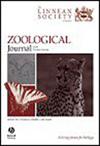Host associations, host switching, geographic location, and potential reticulate evolution shape the systematics of sucking lice (Psocodea: Anoplura) belonging to the genera Hoplopleura and Polyplax
IF 2.8
2区 生物学
Q1 ZOOLOGY
引用次数: 0
Abstract
Sucking lice (Psocodea: Anoplura) represent a species-rich parasite group that shares an intimate evolutionary relationship with their mammalian hosts. Two anopluran genera, Polyplax and Hoplopleura, primarily parasitize rodents and the taxonomy of these lice is mainly based on morphological characters with some inferences derived from host associations. To shed more light on the systematics and the evolutionary mechanisms that gave rise to Polyplax and Hoplopleura species diversity, data derived from the 16S rRNA, COI, 18S rRNA, and EF-1α genes were used to generate a phylogeny for 105 individuals representing ∼56 morphologically identified species. Concatenated data analyses found significant nodal support for five higher level monophyletic Clades among Hoplopleura and four higher level Clades and 15 subclades among Polyplax species. The monophyly of neither Polyplax nor Hoplopleura was supported and topological conflict among individual gene trees resulted in a non-tested hypothesis that ancestral hybridization and/or independent lineage sorting may have shaped the evolution of some Polyplax species. Several species complexes or cryptic divergences were detected specifically within the hoplopleurid species Hoplopleura acanthopus, Hoplopleura arizonensis, Hoplopleura hesperomydis, Hoplopleura oryzomydis, Hoplopleura pacifica, and Hoplopleura sciuricola, and the polyplacid species Polyplax arvicanthis, Polyplax auricularis, Polyplax biseriata, Polyplax myotomydis, Polyplax otomydis, Polyplax reclinata, and Polyplax spinulosa. Four morphological and genetically distinct taxa were sampled from Gerbillinae or Deomyinae and these probably represent new species. The taxonomy of Polyplax and Hoplopleura needs a thorough revision, and the species diversity of these lice can be attributed to an interplay between host associations, host switching and geographic locations of host species.寄主关联、寄主切换、地理位置和潜在的网状进化形成了吸吮虱(Psocodea: Anoplura)的分类学,属于Hoplopleura属和Polyplax属
吸虱是一种种类丰富的寄生虫,与它们的哺乳动物宿主有着密切的进化关系。寄生在啮齿类动物身上的两种无尾虱属(Polyplax)和Hoplopleura,其分类主要基于形态特征,并根据寄主关联进行了一些推断。为了进一步阐明Polyplax和Hoplopleura物种多样性的系统学和进化机制,研究人员利用来自16S rRNA、COI、18S rRNA和EF-1α基因的数据,对105个个体的系统发育进行了分析,这些个体代表了56个形态鉴定的物种。串联数据分析发现,蚤胸科中有5个较高水平的单系支系,多聚科中有4个较高水平的支系和15个亚支系存在显著的节点支持。Polyplax和Hoplopleura的单系性都没有得到支持,单个基因树之间的拓扑冲突导致了一个未经验证的假设,即祖先杂交和/或独立的谱系分类可能影响了一些Polyplax物种的进化。在棘胸膜、棘胸膜、红胸膜、长胸膜、太平洋胸膜和细纹胸膜等多胸膜物种中,以及在多胸膜、耳胸膜、双线胸膜、肌胸膜、耳胸膜、斜胸膜和刺胸膜等多胸膜物种中,发现了多种复种或隐种差异。在Gerbillinae和deominae中分别发现了4个形态和遗传上明显不同的分类群,这些分类群可能代表了新种。Polyplax和Hoplopleura的分类需要彻底的修订,这些虱子的物种多样性可归因于寄主关联、寄主切换和寄主物种地理位置的相互作用。
本文章由计算机程序翻译,如有差异,请以英文原文为准。
求助全文
约1分钟内获得全文
求助全文
来源期刊
CiteScore
6.50
自引率
10.70%
发文量
116
审稿时长
6-12 weeks
期刊介绍:
The Zoological Journal of the Linnean Society publishes papers on systematic and evolutionary zoology and comparative, functional and other studies where relevant to these areas. Studies of extinct as well as living animals are included. Reviews are also published; these may be invited by the Editorial Board, but uninvited reviews may also be considered. The Zoological Journal also has a wide circulation amongst zoologists and although narrowly specialized papers are not excluded, potential authors should bear that readership in mind.

 求助内容:
求助内容: 应助结果提醒方式:
应助结果提醒方式:


